READING COMPREHENSION is associated with excellent academic performance, and the quality of learning, as it facilitates the acquisition and mastery of knowledge, which can be applied by the student both inside and outside the school (Ministério da Educação, 2019; García, Arévalo, & Hernández, 2018). The ability to comprehend what is read is influenced by students' motivation, mainly regarding engagement and maintaining interest in activities that involve reading and their adherence to learning strategies (Bzuneck & Boruchovitch, 2016; Stutz, Schaffner, & Schiefele, 2016).
Both motivation and the development of appropriate learning strategies are resources that must be considered and encouraged by school psychologists and teachers working in primary education. The mapping of the student's motivational and strategic profile enables the development of activities more suitable for classroom learning (Ministério da Educação, 2019). In the present study, we investigated motivation through achievement goals and self-efficacy beliefs concerning Middle School students' reading comprehension.
Achievement goals refer to how motivation can affect students' behavior about their school activities and academic routine (Senko, Hulleman, & Harackiewicz, 2011). They are defined based on the objectives and the quality of the student's engagement in a given task. Each goal has a value attributed to the school activities, and this is why the student gets involved and strives throughout the learning process (Ames, 1992). The reading comprehension achievement goals investigated were the learning goal, performance-approach goal, and performance-avoidance goal (Bzuneck & Boruchovitch, 2016; Senko et al., 2011).
Students with a motivational profile for the learning goal use more effective learning strategies, are creative when performing their school tasks, adhere better to challenges, and believe that good performance is achieved through their effort, increasingly seeking their intellectual development. This goal is positively correlated with reading comprehension (Anderman, Anderman, Yough, & Gimbert, 2010; Santos, Moraes, & Lima, 2018; Senko & Hulleman, 2013), as well as being associated with excellent academic performance (Zenorini, Santos, & Monteiro, 2011).
In the motivational orientation of the performance-approach goal, the students prioritize public recognition and "doing better than others", preferring tasks with a particular social prestige. They depend on external reinforcements to feel successful (Anderman et al., 2010; Senko & Hulleman, 2013). This goal is strongly associated with competition (Senko & Dawson, 2017; Senko et al., 2011). Students guided by the performance-avoidance goal tend to avoid activities that demonstrate their disability, preferring to perform tasks within their proficiency, with their main fear being exposed to others' judgment (Bzuneck & Boruchovitch, 2016). Students that actively adopt this goal tend to have low expectations regarding their competence, and therefore, consider tasks as complex and outside their skill level (Anderman et al., 2010; Darnon, Butera, Mugny, Quiamzade, & Hulleman, 2009).
Although these three achievement goals have different characteristics, they can act jointly or alternately depend on, for example, the type of task (e.g., reading comprehension, arts, physical activity) or the configuration of the classroom (teacher-student interpersonal relationships, competitiveness among classmates) (Cardoso & Bzuneck, 2004; Peixoto et al., 2017; Zenorini & Santos, 2010). Thus, the relationships among these achievement goals were also the subject of investigation in the present study.
Self-efficacy is another motivational construct investigated in this study. It refers to the individual's beliefs in their own ability to manage the means necessary to achieve a particular objective, including when to start it, the effort spent, and the time that it will be maintained through the difficulties encountered (Bandura, 1978). Its evaluation occurs through specific domains, being chosen for the present study the self-efficacy for the reading comprehension linked to the student's quality of involvement and reading comprehension performance (Butz & Usher, 2015). Thus, self-efficacy beliefs can be defined as the students' judgment of their ability to comprehend what they read (Unrau et al., 2017; Yogurtscu, 2013). Accordingly, students who perceive themselves as good readers understand reading as a gratification source tend to read more often and persevere in more complex texts. In contrast, students who perceive themselves as unable to understand reading may not recognize this activity's positive experiences when they need to read. It can make them avoid tasks that involve reading, especially when they need great effort because they already think that they will fail (Unrau et al., 2017).
According to Yogurtscu (2013), students who have stronger self-efficacy beliefs regarding reading comprehension use more effective reading strategies. Readers use these strategies to understand the content read and are associated with planning, identifying the purpose of reading, making decisions, monitoring understanding, and evaluating the text's experience (Roomy & Alhawsawi, 2019). The mastery of appropriate and diversified strategies allows for proficient and more independent reading (Rastlegar, Kermani, & Khabir, 2017) . More competent readers usually know the different reading strategies they can employ and decide when and which ones to use. Therefore, it is evident that reading comprehension is not influenced by just one factor and homogeneously. It is a mutual influence between motivational and instrumental constructs (Bandura & Schunk, 1981), and metalinguistic skills as phonological awareness and morphological awareness were not the focus of this study.
In addition to self-efficacy, another way of knowing the students' perception of themselves regarding reading comprehension skills is through self-evaluation. Through the self-assessment, students describe themselves, evaluating themselves, and attributing merit to their learning processes. This variable is positively related to students' academic success (Panadero, García-Pérez, & Fraile, 2018) . In Middle School, the way students evaluate themselves predicts how they interpret the causes attributed to academic success and failure (Ferraz, Santos, & Almeida, 2019). The incentive to carry out self-evaluations allows students to more actively explore their school grades and feedback about their performance, favoring learning and is also beneficial for the proper use of learning strategies and the development of positive self-efficacy beliefs (Panadero, Jonsson, & Botella, 2017).
In the school environment, reading is often not developed due to its solely instrumental character, making reading just a decoding exercise. This type of treatment given to reading is one of the causes of the students' difficulties in performing activities that require reading comprehension, the lack of pleasure, and not developing the reading habits (Oliveira, Santos, & Rosa, 2016). Reading refers not only to educational content, but also to recreational reading, composed of a diversity of other materials provided in printed or digital media (Baptista et al., 2016). The study by Epcacan and Damirel (2011) indicates that students with access to reading materials (e.g., newspapers, magazines) have stronger self-efficacy beliefs in this skill than students whose families do not have socioeconomic conditions to provide these resources for their children.
Based on the above, the present study aimed to investigate the relationships among achievement goals for reading comprehension activities, self-efficacy, and learning strategies in Brazilian Middle School students. We examined the relationships among the three achievement goals-learning goal, performance-approach goal, and performance-avoidance goal. We also investigated the relationship between these constructs with the students' self-evaluation of reading comprehension and Portuguese. Sample characteristics as the history of repetition, the school year, age, and sex were considered control variables in the investigated associations. This research's last objective was to compare the differences between the students' self-evaluation of performance with their recreational reading practice.
Hypotheses identified the identification of positive correlations of weak to moderate magnitude between self-efficacy, reading strategies, self-evaluation of students' performance in reading comprehension and Portuguese language with the learning goal and performance-approach goal (Panadero et al., 2017; Senko et al., 2011; Unrau et al., 2017), and negative correlations the performance-avoidance goal (Darnon et al., 2009; Korpershoek, Kuyper, & van der Werf, 2014; Richey, Bernacki, Belenky, & Nokes-Malach, 2017). It was assumed that the variables able to exercise control in the partial correlation analyses would signiicantly affect the associations. It was conjectured that achievement goals would have predictive potential in self-efficacy and strategies for reading comprehension, and performance self-evaluation would be predictors of these three constructs (Cho, Toste, Lee, & Ju, 2018; Ferraz et al., 2019; Lau, 2018).
We expected to identify positive correlations between the learning goal and performance-approach goal, negative correlations between the learning goal and performance-avoidance goal, and performance-approach with performance-avoidance goals. Despite having different definitions, they share common characteristics, acting alternately or concomitantly depending on the school climate and knowledge domain (Cardoso & Bzuneck, 2004; Cho et al., 2018; Elliot & Murayama, 2008). It was also expected that students with a higher self-evaluation rate in reading comprehension and Portuguese would be the ones who most adhere to the practice of recreational reading and vice versa (Goudeau & Croizet, 2016; Stack, Moorefield-Lang, & Barksdale, 2015).
Method
Participants
The participants were 47 students enrolled in the 6th to 9th grade of Middle School from two public schools of the state of São Paulo, 44.7% (N=21) being female and 55.3% (N=26) male. Regarding the school years, 14.9% (N=7) were in the 6th year, 34% (N=16) in the 7th year, 19.1% (N=9) in the 8th year, and 31.9% (N=15) in the 9th year. The minimum age was ten years, and the maximum 16 years (N=13.05; SD=1.55). Regarding school history, 27.7% (N=13) of the participants had repeated at least one school year.
Instruments
Identification Questionnaire (Ferraz & Santos, 2019). This questionnaire was applied to collect data to characterize the sample. The students reported their age, sex, school year, the existence of a history of repetition, and whether they practiced recreational reading. It also requested a self-evaluation of the student's reading comprehension and the Portuguese language. The students answered questions on a Likert-type scale from 0 to 10 points.
The instruments used to assess the reading comprehension achievement goals, self-efficacy, and strategies are part of the Multidimensional Self-Regulatory Learning Battery-Reading Comprehension (Bateria Multidimensional da Autorregulação para a Compreensão de Leitura -BAMA-Leitura) (Ferraz & Santos, 2019). The BAMA-Reading comprises nine scales aimed at evaluating the self-regulation of Middle School students. The instrument has evidence of content validity (Ferraz & Santos, 2019). The BAMA-Reading scales can be applied individually or collectively, with no minimum or maximum time pre-established for students to respond to them. The scales used in the present study are described below.
Reading Comprehension Achievement Goals Scale (Escala Metas de Realização para a Compreensão de Leitura - EMR-CL, Ferraz & Santos, 2019). This scale assesses motivational proiles guided by achievement goals for reading comprehension activities. The scale has 18 items divided into three factors: Learning Goal (e.g., Understanding what I read is a way of learning new things.); Performance-Approach Goal (e.g., I try to read various books so that people think I am intelligent); Performance-Avoidance Goal (e.g., I give up on reading the text when it is difficult to understand). The answer key is a 4-point Likert-type scale, ranging from Not True to Totally True.
Reading Comprehension Self-Efficacy Scale (Escala Autoeficáciapara a Compreensão de Leitura-EMR-CL, Ferraz & Santos, 2019). This scale has a unidimensional structure and is composed of 21 items that assess the students' perceptions of their ability to perform tasks that involve reading comprehension skills (e.g., When reading, I organize the primary information of the text). The response format is a 4-point Likert-type scale that ranges from Not capable to Totally capable.
Reading Comprehension Methods Scale (Escala Métodos para Compreender a Leitura-EM-CL, Ferraz & Santos, 2019). The EM-CL assesses the students' use of reading comprehension strategies. This scale is unidimensional and has 18 items, answered on a 4-point Likert-type scale that varies from Never to Always. An example of an item is: As I read, I think of questions about the text.
Data Collection Procedure
This study is part of a larger project currently underway, approved by the university's Ethics Committee to which it is linked (Authorization No. 3.263.350). This study's execution followed the procedures established by Resolution 510/2016 of the National Health Council (Conselho Nacional de Saúde, 2016). Data collection was carried out in two schools located in the state of São Paulo. The study subjects were students who returned the consent form signed by one of the parents/ guardians and signed the mandatory consent term for students over ten years of age.
Data collection occurred collectively, in the classroom, during the class period, at times defined by each school's directors. The instruments were applied in the following order: Identification Questionnaire, EMR-CL, EA-CL, and EM-CL. The average time to complete the instruments was 30 minutes. Exclusion criteria established were students diagnosed with a global developmental disorder (e.g., autism spectrum disorder) and students with visual impairment. These criteria were stipulated as they might not have well-established reading comprehension abilities. Their responses to the instruments could be affected by the monitors that accompanied them in the classroom.
Data Analysis
Data were analyzed using the Statistical Package for the Social Sciences (spss; V. 22.0) software. Data's normality was verified using the Kolmogorov-Smirnov test, indicated for samples with 30 to 100 people. This test indicated the normality of the EMR-CL, EA-CL, and EM-CL factors, with p >.05, which enabled parametric analyses.
Descriptive analyses were used to characterize the sample and verify the instruments' means and standard deviations. As the number of items on the scales varies, the performance comparison was based on the weighted mean derived from the Likert-type scale (M=2) and the standard deviation value.
Instruments' relationships were investigated using bivariate and partial Pearson's r correlation test. The interpretation of the magnitude of the correlations followed r<.30, weak; .40 to .60 moderate; r>.70, strong (Dancey & Reidy, 2013). Control variables were selected using the significance test for Pearson's X2 cross-tabulation C05. The variables history of repetition, school year, age, and sex were tested, and the first three met the requirements to be included as a control variable (Table 1).
Table 1 Cross-Tabulation: School Year, History of Repetition, Age, and Gender
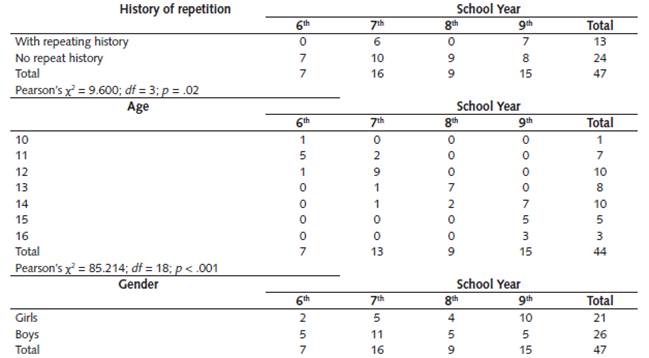
Pearson's x 2 = 4.836; df = 3; p =.2
Note: Categories' proportions do not differ from each other, p > .05.
Simple linear regression analysis (enter method) was used to test one independent variable to guarantee a minimum of 20 cases per predictor. We used the Durbin-Watson test to assess the autocorrelation in the residues. This teste's values are between 1.5 and 2.5 (Field, 2013). Student's t-test was used to compare groups. The interpretation of the effect size ofthis comparison's statistical significance was based on the parameters d<.20, small, from .30 to .70, medium; d>.80, large (Cohen, 1988).
Results
The correlations existing in the EMR-CL, EA-CL, and EM-CL were examined to investigate the relationships between achievement goals, self-efficacy, and strategies to comprehend reading. Table 2 shows that the statistically significant correlations between achievement goals with reading self-efficacy and reading strategies varied from moderate to strong magnitude. These correlations' direction was positive for reading self-efficacy and reading strategies with the learning and performance-approach goals and negative with the performance-avoidance goal.
Table 2 Means, Standard Deviations and Correlations of the EMR-CL, EA-CL, and EM-CL1
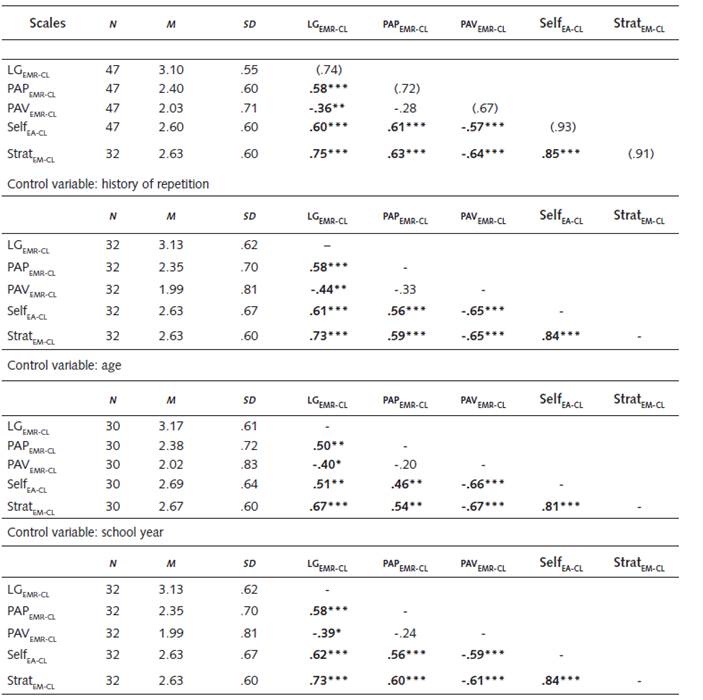
Legend, M = Mean; SD = Standard Deviation; LGemr-cl = Learning Goal; PAPemr_cl = Performance-Approach Goal; PAVemr cl = Performance-Avoidance Goal; SelfEA-CL = Reading Comprehension Self-Efficacy; StratEM cl = Reading Comprehension Strategies.
Note: Values in parentheses = alpha coefficient as a measure of the internal consistency of the instrument's factors.
Note: Coefficients in bound indicate statistically significant correlations: *p <.05; **p <.01; ***p <.001.
The learning goal correlated positively with the performance-approach goal (moderate magnitude) and negatively with the performance-avoidance goal (weak magnitude). No statistically significant correlations were identified between the performance-approach goal and the performance-avoidance goal.
The partial correlations compared to the bivariate correlations kept the same sense of the associations and their statistical significance. There were an increase and a decrease in the partial correlations (Table 2) depending on the control variable (except for the correlation between the performance-avoidance goal and the learning goal in the historical repetition control and school year variables). When controlling for age, it is noteworthy that the partial correlation between learning and performance-avoidance goals, from low magnitude in the bivariate correlation to moderate magnitude. This result indicates that the existing relationships between achievement goals with self-efficacy and reading comprehension strategies are interfered with by the repetition history, age, and school years that make up Middle School.
Next, we investigated the predictive potential of the achievement goals for both reading self-efficacy and reading strategies1. Table 3 shows that the performance-approach goal and learning goal presented, respectively, 36% and 35% of the explained variance in reading comprehension self-efficacy (positive β). The performance-avoidance goal presented 31% of the explained variance in reading comprehension self-efficacy, with negative β, by the direction of the correlation identified in both motivational constructs in the correlation analysis (Table 2). The reading comprehension strategies had the variance explained, predominantly, by the learning goal (55%), followed by the performance-approach goal (positive p). The performance-avoidance goal accounted for 39% of the explained variance in reading comprehension strategies (negative β).
Table 3 Simple Linear Regression of the Value Assigned by Achievement Goals for Reading Comprehension Self-Efficiency and Strategies
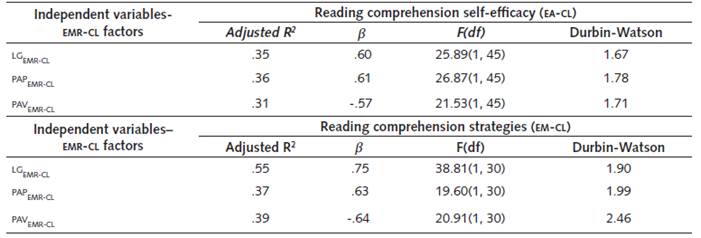
Note: LGEMR-CL = Learning Goal; PAPEMR-CL = Performance-Approach Goal; PAVEMR-CL = Performance-Avoidance goal; M = Regression Coefficient; df = Degrees of Freedom
*p <.001
Considering this study's aims, we investigated the relationships between reading comprehension in achievement goals, self-efficacy and strategies, and the students' self-evaluation of their reading comprehension and the Portuguese language. Both self-evaluations presented a positive bivariate correlation of moderate magnitude (r=.64; p<.001). When verifying the partial correlations compared to the bivariate correlation, there was no change in the value considering the variables age and school year. However, this difference was identified in the partial correlation that controlled the repetition history (r=.60; p<.001). This result suggests that, on the one hand, the school years and age do not interfere in the way students self-evaluate their performance in reading comprehension and the Portuguese language. On the other hand, repetition of history can change the way students realize their ability in these knowledge areas.
Table 4 shows Pearson's r correlations for the variables investigated. There were bivariate correlations of weak to moderate magnitude for the self-evaluation of the students' reading comprehension and Portuguese language performance. Negative correlations were identified between both self-evaluations and the performance-avoidance goal. The correlations did not show statistical significance with the self-evaluation of the reading comprehension performance for the learning goal and performance-approach goal.
Table 4 Descriptive Analysis and Correlations of the Students' Self-Assessments of Reading Comprehension and Portuguese Language with the EMR-CL, EA-CL, and EM-CL
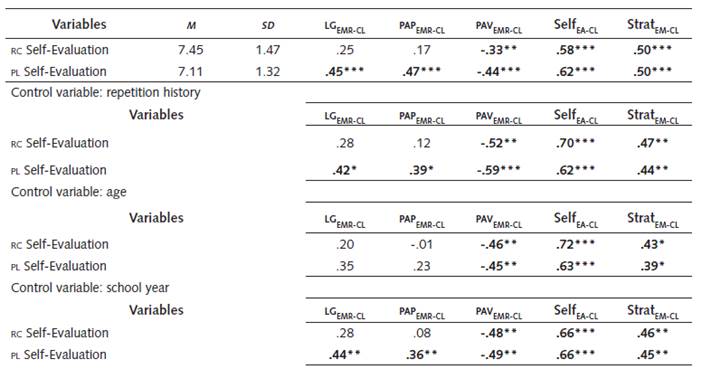
Legend. RC = Reading Comprehension; PL = Portuguese language; M = Mean; so = Standard Deviation; LGemr-cl = Learning Goal; PAPemr-cl = Performance-Approach Goal; PAVemr-cl = Performance-Avoidance Goal; SelfEA-CL = Reading Comprehension Self-Efficacy; StratEM-CL = Reading Comprehension Strategies.
Note: w=47
Note: Coefficients in bound indicate statistically significant correlations: *p <.05; **p <.01; ***p <.001.
When controlling for age, Table 4 shows that the bivariate correlations of moderate magnitude between the Portuguese self-evaluation and the learning and performance-approach goals are no longer statistically significant in the partial correlations with age control. When comparing the indexes of the other partial correlations that were statistically significant, there is an increase or decrease in their values concerning the bivariate correlations (except for the partial correlation between the Portuguese self-evaluation and the self-efficacy for reading comprehension with control of repetition history).
It is noteworthy that the weak bivariate correlation between the Portuguese self-evaluation and the goal performance-avoidance becomes of moderate magnitude when controlling the three variables in the partial correlations. In turn, there was a decrease in the correlation' magnitudes between the Portuguese self-evaluation and the performance-approach goal, from moderate to weak magnitude with the control of repetition history and school year. The same is observed with age control in the partial correlation between this measure of self-rated performance and strategies for reading comprehension. There was an increase in partial correlations between reading comprehension self-evaluation and self-efficacy, from moderate magnitude in the bivariate correlation to the strong magnitude with the control of repetition history and age. The control variables affected in correlations between the constructs were based on these results.
Subsequently, we investigated the predictive potential of the achievement goals, reading comprehension self-efficacy, reading comprehension strategies, and the Portuguese language self-evaluation of the students. The performance-avoidance goal explained 19% of the variance for the student's self-evaluation of the Portuguese language performance and 9% for the reading comprehension (negative (3). The performance-approach goal and the learning goal were predictors of the reading comprehension self-evaluation (explained variance of 20 and 19%, respectively). Neither achievement goals were statistically significant for the self-evaluation of reading comprehension performance. Reading comprehension self-efficacy and strategies predicted the Portuguese language performance self-evaluation (38% and 33% of explained variance, respectively) and reading comprehension (both with 23% explained variance).
Table 5 Simple Linear Regression of the Value Assigned by the EMR-CL, EA-CL, and EM-CL
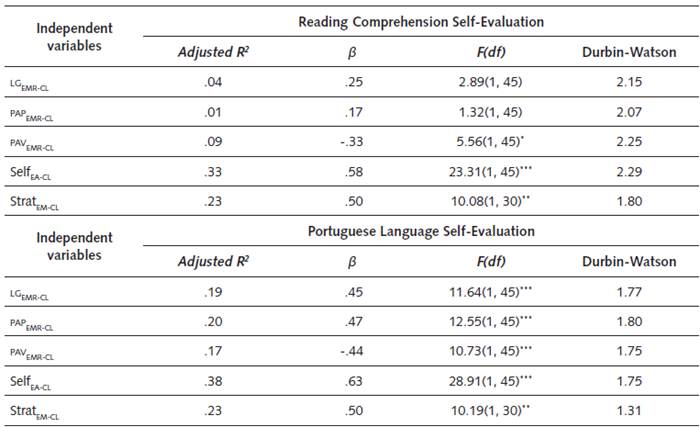
Note: LGemrcl = Learning Goal; PAPemrcl = Performance-Approach Goal; PAVemrcl = Performance-Avoidance Goal; SelfEACL = Reading Comprehension Self-efficacy; StratEM-CL = Reading Comprehension Strategies; P = Regression Coefficient; df = Degrees of Freedom.
* p <.05; **p <.01; ***p <.001
Differences in the students' self-evaluation of their reading comprehension and Portuguese language performance were also investigated according to the habit of recreational reading. Table 6 shows that the students that indicated having this habit presented a higher self-evaluation of their reading comprehension and Portuguese performance. The effect size of the statistical significance of the differentiation in both self-evaluations of students' performance was practically null (possibly due to the sample size).
Discussion
This study found that the motivational profile guided by the learning goal, in which the interest of the student is more intrinsic than extrinsic (Stutz et al., 2016), also is related to the use of learning strategies, as well as to beliefs of self-efficacy for activities that require reading comprehension proficiency. These results corroborate the idea that reading to increase knowledge can make the student more critical and autonomous in assessing which strategies are most suitable for carrying out activities that involve reading comprehension (Unrau et al., 2017). Through positive experiences derived from the proper application of reading strategies, the learning goal's motivation can also increase the student's self-efficacy beliefs regarding reading comprehension activities (Anderman et al., 2010; Rastlegar et al., 2017; Santos et al., 2018; Senko & Hulleman, 2013).
The orientation towards the performance-approach goal also contributes positively to reading strategies and reading self-efficacy. Using strategies that lead to excellent performance is a way for students orientated towards this motivational profile to have their performance recognized (Bzuneck & Boruchovitch, 2016; Zenorini et al., 2011). It is also assumed that when teachers and colleagues recognize the effort and ability to understand reading, there is an increase in the student's perception of self-efficacy towards the performance-approach goal. This hypothesis arises because this goal is strongly associated with competition, and the vision of success is linked to the achievement of superior performance compared to peers (Senko & Dawson, 2017; Senko & Hulleman, 2013; Senko et al., 2011).
The orientation towards the performance-avoidance goal proved to be unfavorable for reading comprehension strategies and, also, for the student's self-efficacy. According to Darnon et al. (2009), students that substantially adhere to the performance-avoidance goal may present low performance because they consider the task very difficult for their skill level since they have low expectations regarding their competence. According to Papinczak, Young, Groves, and Haynes (2008), low self-efficacy beliefs can lead the student to adhere to a simple approach in their studies, restricting themselves, for example, to memorization strategies to perform tests.
Regarding the correlations between the achievement goals, we found that the learning goal and the performance-approach goal have common characteristics. It indicates that they can act together in the same reading comprehension task (Cardoso & Bzuneck, 2004; Elliot & Murayama, 2008). This union can help the student mobilize motivational and instrumental resources (learning self-efficacy and strategies) to perform activities that require reading comprehension (Abd-El-Fatta, 2018; Bandura & Schunk, 1981).
Conversely, the negative direction of the correlation between the learning goal and the performance-avoidance goal suggests that the characteristics that compose them are divergent. Therefore, the student with a motivational profile for the learning goal, characterized by adherence to reading comprehension activities, considers the challenging and pleasurable, will not assess these tasks as something aversive. We identified the opposite in the performance-avoidance goal. The student orientation towards this goal tends to perceive tasks that involve reading comprehension as something unattractive and threatening, especially when exposed to more complex reading materials that demand a more considerable effort. However, in the learning goal, greater engagement in these tasks is expected due to the preference of this motivational profile for challenges (Korpershoek et al., 2014; Richey et al., 2017; Zenorini & Santos, 2010).
We found that the negative correlation between the performance-approach and performance-avoidance goals was not statistically significant. This result was expected due to the distinct characteristics identified in thinking and acting by students guided by these goals (Senko et al., 2011; Zenorini & Santos, 2010). However, there are indications that both achievement goals may converge due to anxiety. In contrast, both students want to be recognized for their excellent performance and at the same time are afraid of not being successful and being exposed due to low achievement (Peixoto et al., 2017; Senko et al., 2011; Zenorini & Santos, 2010). The instrument used to assess reading comprehension achievement goals has only one item in the performance-avoidance goal factor that addresses nervousness (Senko et al., 2011). This relationship can be better explained in future research by assessing achievement goals and anxiety.
Concerning the students' self-evaluation of their performance, motivational profiles guided by the learning and performance-approach goals, reading self-efficacy, and reading strategies contribute positively to the way the student self-evaluates, mainly in the Portuguese language (Panadero et al., 2017; Unrau et al., 2017; Yogurtscu, 2013). In turn, the negative impact of the performance-avoidance goal on the students' self-evaluation of their performance may reflect the fear and anxiety to perform more complicated reading comprehension and Portuguese language activities (Bzuneck, 2009; Peixoto et al., 2017; Senko et al., 2011; Zenorini & Santos, 2010).
Based on the present study results, the student's self-evaluation of performance tends to be associated with motivation and skills linked to reading comprehension proficiency as reading strategies. However, how the students evaluate themselves is, to some extent, characterized as a subjective attribute (Ferraz et al., 2019). Thus, it is necessary to verify whether the performance self-evaluation is compatible with the student's concrete academic performance and contextual variables in the school climate (Cho et al., 2018).
For example, in the first years of elementary school, greater difficulty for students to evaluate themselves in a congruent way with their performance at school has been identified, with this tending to be overcome with the advancing school years (Ferraz et al., 2019). Referring to the educational implications of self-evaluation, the meta-analysis conducted by Panadero et al. (2017) warns that this skill needs to be implemented in different teaching situations, not just by it improves performance but because it impacts self-efficacy and strengthening learning. In this study, we identified that the history of repetition, the school year, and age are associated with the correlations between self-evaluation measures and the constructs investigated. Therefore, these variables' impact is not restricted to associations and performance differences in motivational aspects and self-regulatory strategies and how they evaluate their performance (Cho et al., 2018; Lau, 2018).
The students that practiced recreational reading presented higher self-evaluations of their reading comprehension performance than those that read only the teaching materials. This result suggests that the way students value reading comprehension from contact with materials that are not just didactic is linked to the development of awareness about its importance, which is not restricted to the learning of school contents (Goudeau & Croizet, 2016; Oliveira et al., 2016; Stack et al., 2015). The habit of reading outside of school also proves to be beneficial for student self-efficacy for activities that involve reading (Epcacan & Damírel, 2011; Panadero et al., 2017).
These results indicate that in future studies, the sample size should be expanded to broaden the investigation of the relationships between the constructs and skills reported here, forming explanatory models that consider the interference of variables linked to students as those analyzed in this study. In addition to motivation and learning strategies, other aspects that may contribute to the development of reading comprehension proficiency in Middle School should be included, as time management and self-monitoring of the effectiveness of the strategies used in reading activities (García et al., 2018; White & DiBenedetto, 2015). Concerning contextual variables in the school environment, research on recreational reading can be complemented with questions that investigate the existence of a library in the school, the collection available in that space, such as books and magazines, and the way the students use it (Baptista et al., 2016). When considering the family aspect, it is necessary to ascertain the educational level of the student's parents/guardians (cultural attribute) and the socioeconomic resources available to acquire reading materials (Epcacan & Damirel, 2011).
In terms of practical implications, this study demonstrated that motivation varies according to the students' commitment related to their achievement goal orientations. This impacts on the use of reading strategies, reading self-efficacy, and the self-evaluation of performance. In addition to this knowledge, the psychologist can use instruments that assess students' motivational constructs and skills to better understand the different motivational profiles of students. With this, it is possible that this professional, together with the pedagogical coordinators and teachers, can establish ways of teaching that consider how students perceive reading comprehension activities to make them increasingly attractive and present in their daily lives.















